HRM Strategies and Flexible Working Practices at Unilever: A Report
VerifiedAdded on 2020/01/23
|22
|6430
|50
Report
AI Summary
This report provides a comprehensive analysis of Human Resource Management (HRM) practices at Unilever. It begins by examining the application of the Guest and Storey's models, evaluating their impact on employee engagement and organizational strategy. The report then delves into the implementation and implications of flexible working arrangements, such as flexible hours, compressed schedules, job sharing, and telecommuting, assessing their effects on both employees and line managers. Furthermore, it explores various performance management methods, comparing their effectiveness in enhancing employee productivity and addressing potential discrimination issues within the company. The report highlights the benefits of these practices in improving employee satisfaction, productivity, and overall organizational performance, including the importance of strategic HRM in achieving financial and behavioral outcomes. This report analyzes the strategic approach to HRM at Unilever, the implications for line managers and employees, and the effects of different types of flexibility at the workplace, such as flexible working hours, compressed working schedules, job sharing, and telecommuting.
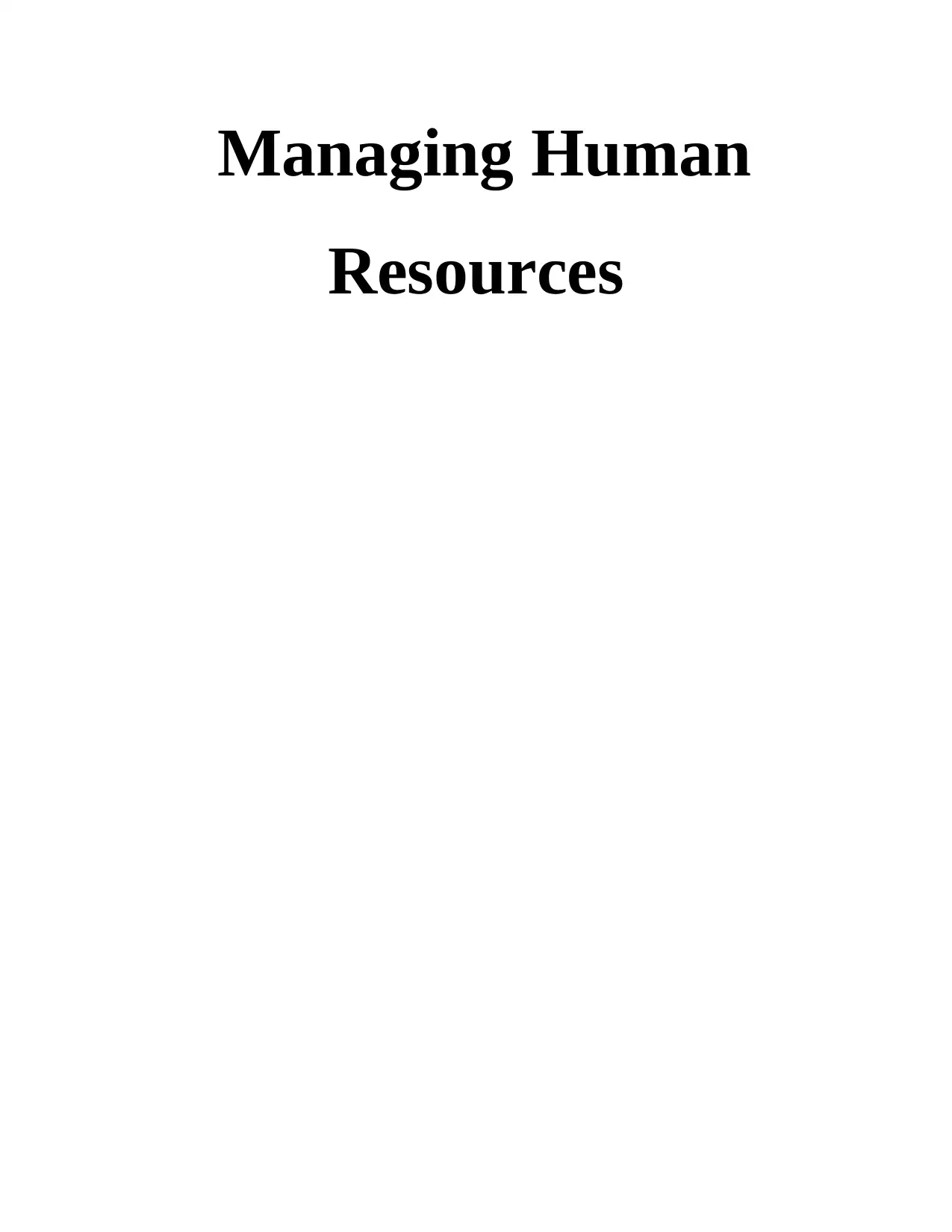
Managing Human
Resources
Resources
Paraphrase This Document
Need a fresh take? Get an instant paraphrase of this document with our AI Paraphraser
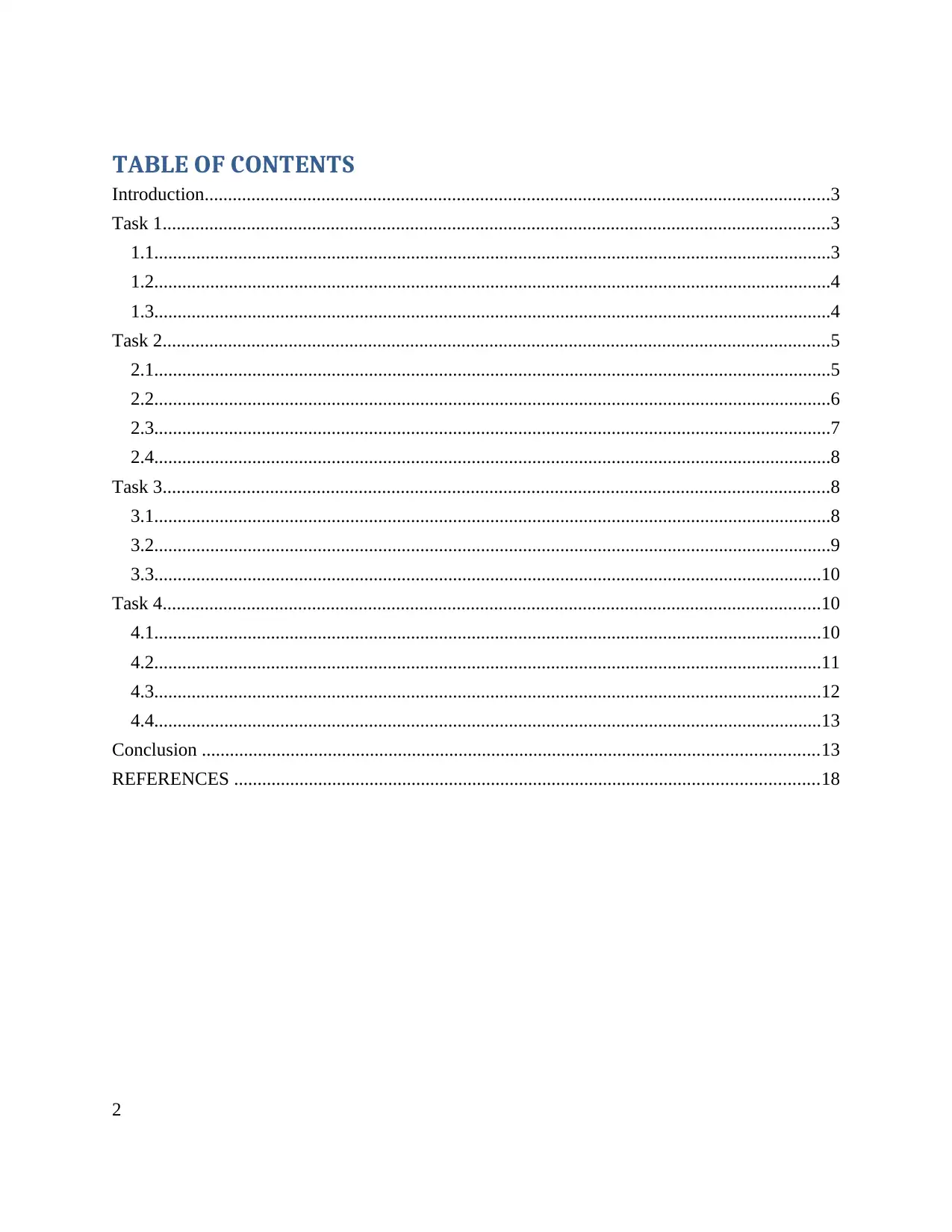
TABLE OF CONTENTS
Introduction......................................................................................................................................3
Task 1...............................................................................................................................................3
1.1.................................................................................................................................................3
1.2.................................................................................................................................................4
1.3.................................................................................................................................................4
Task 2...............................................................................................................................................5
2.1.................................................................................................................................................5
2.2.................................................................................................................................................6
2.3.................................................................................................................................................7
2.4.................................................................................................................................................8
Task 3...............................................................................................................................................8
3.1.................................................................................................................................................8
3.2.................................................................................................................................................9
3.3...............................................................................................................................................10
Task 4.............................................................................................................................................10
4.1...............................................................................................................................................10
4.2...............................................................................................................................................11
4.3...............................................................................................................................................12
4.4...............................................................................................................................................13
Conclusion ....................................................................................................................................13
REFERENCES .............................................................................................................................18
2
Introduction......................................................................................................................................3
Task 1...............................................................................................................................................3
1.1.................................................................................................................................................3
1.2.................................................................................................................................................4
1.3.................................................................................................................................................4
Task 2...............................................................................................................................................5
2.1.................................................................................................................................................5
2.2.................................................................................................................................................6
2.3.................................................................................................................................................7
2.4.................................................................................................................................................8
Task 3...............................................................................................................................................8
3.1.................................................................................................................................................8
3.2.................................................................................................................................................9
3.3...............................................................................................................................................10
Task 4.............................................................................................................................................10
4.1...............................................................................................................................................10
4.2...............................................................................................................................................11
4.3...............................................................................................................................................12
4.4...............................................................................................................................................13
Conclusion ....................................................................................................................................13
REFERENCES .............................................................................................................................18
2
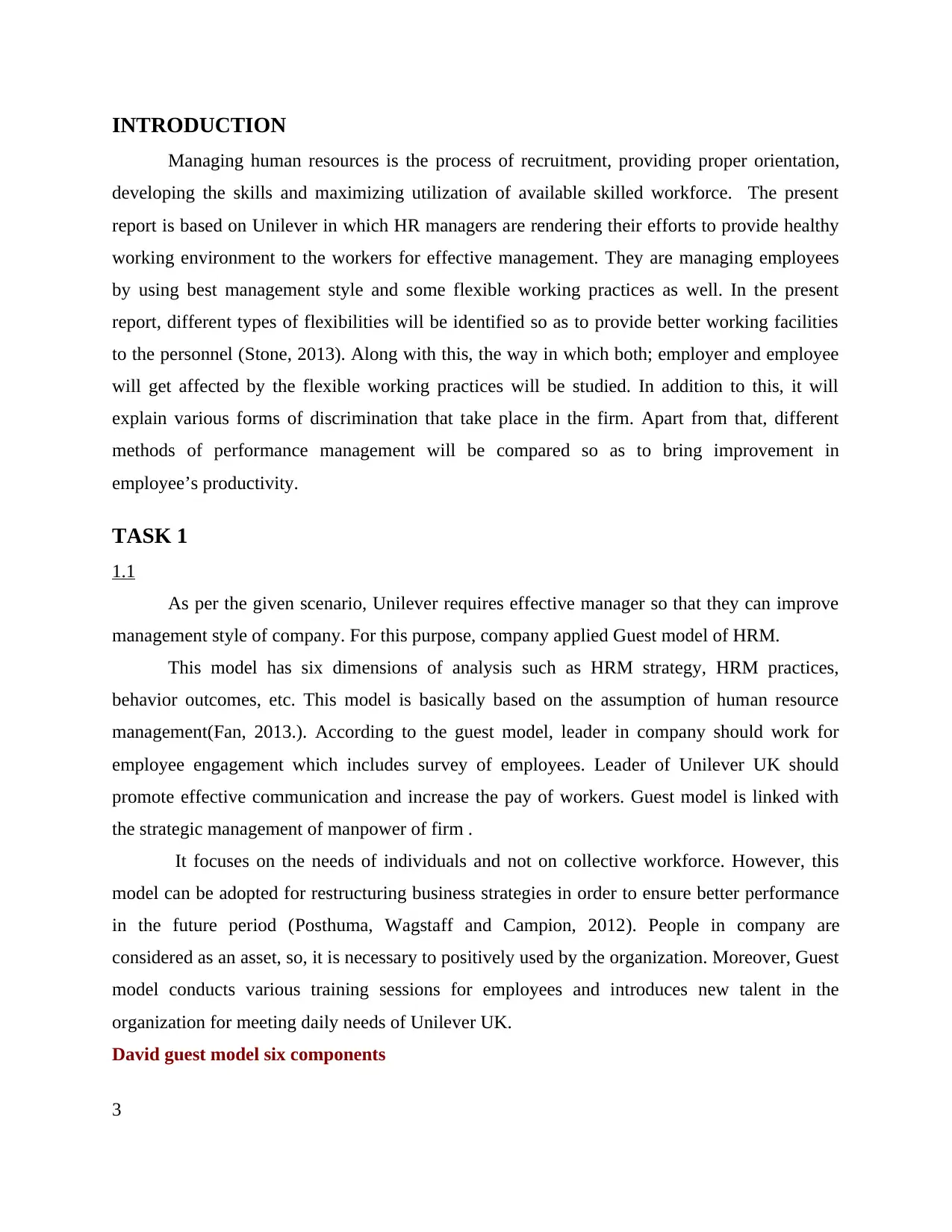
INTRODUCTION
Managing human resources is the process of recruitment, providing proper orientation,
developing the skills and maximizing utilization of available skilled workforce. The present
report is based on Unilever in which HR managers are rendering their efforts to provide healthy
working environment to the workers for effective management. They are managing employees
by using best management style and some flexible working practices as well. In the present
report, different types of flexibilities will be identified so as to provide better working facilities
to the personnel (Stone, 2013). Along with this, the way in which both; employer and employee
will get affected by the flexible working practices will be studied. In addition to this, it will
explain various forms of discrimination that take place in the firm. Apart from that, different
methods of performance management will be compared so as to bring improvement in
employee’s productivity.
TASK 1
1.1
As per the given scenario, Unilever requires effective manager so that they can improve
management style of company. For this purpose, company applied Guest model of HRM.
This model has six dimensions of analysis such as HRM strategy, HRM practices,
behavior outcomes, etc. This model is basically based on the assumption of human resource
management(Fan, 2013.). According to the guest model, leader in company should work for
employee engagement which includes survey of employees. Leader of Unilever UK should
promote effective communication and increase the pay of workers. Guest model is linked with
the strategic management of manpower of firm .
It focuses on the needs of individuals and not on collective workforce. However, this
model can be adopted for restructuring business strategies in order to ensure better performance
in the future period (Posthuma, Wagstaff and Campion, 2012). People in company are
considered as an asset, so, it is necessary to positively used by the organization. Moreover, Guest
model conducts various training sessions for employees and introduces new talent in the
organization for meeting daily needs of Unilever UK.
David guest model six components
3
Managing human resources is the process of recruitment, providing proper orientation,
developing the skills and maximizing utilization of available skilled workforce. The present
report is based on Unilever in which HR managers are rendering their efforts to provide healthy
working environment to the workers for effective management. They are managing employees
by using best management style and some flexible working practices as well. In the present
report, different types of flexibilities will be identified so as to provide better working facilities
to the personnel (Stone, 2013). Along with this, the way in which both; employer and employee
will get affected by the flexible working practices will be studied. In addition to this, it will
explain various forms of discrimination that take place in the firm. Apart from that, different
methods of performance management will be compared so as to bring improvement in
employee’s productivity.
TASK 1
1.1
As per the given scenario, Unilever requires effective manager so that they can improve
management style of company. For this purpose, company applied Guest model of HRM.
This model has six dimensions of analysis such as HRM strategy, HRM practices,
behavior outcomes, etc. This model is basically based on the assumption of human resource
management(Fan, 2013.). According to the guest model, leader in company should work for
employee engagement which includes survey of employees. Leader of Unilever UK should
promote effective communication and increase the pay of workers. Guest model is linked with
the strategic management of manpower of firm .
It focuses on the needs of individuals and not on collective workforce. However, this
model can be adopted for restructuring business strategies in order to ensure better performance
in the future period (Posthuma, Wagstaff and Campion, 2012). People in company are
considered as an asset, so, it is necessary to positively used by the organization. Moreover, Guest
model conducts various training sessions for employees and introduces new talent in the
organization for meeting daily needs of Unilever UK.
David guest model six components
3
⊘ This is a preview!⊘
Do you want full access?
Subscribe today to unlock all pages.

Trusted by 1+ million students worldwide
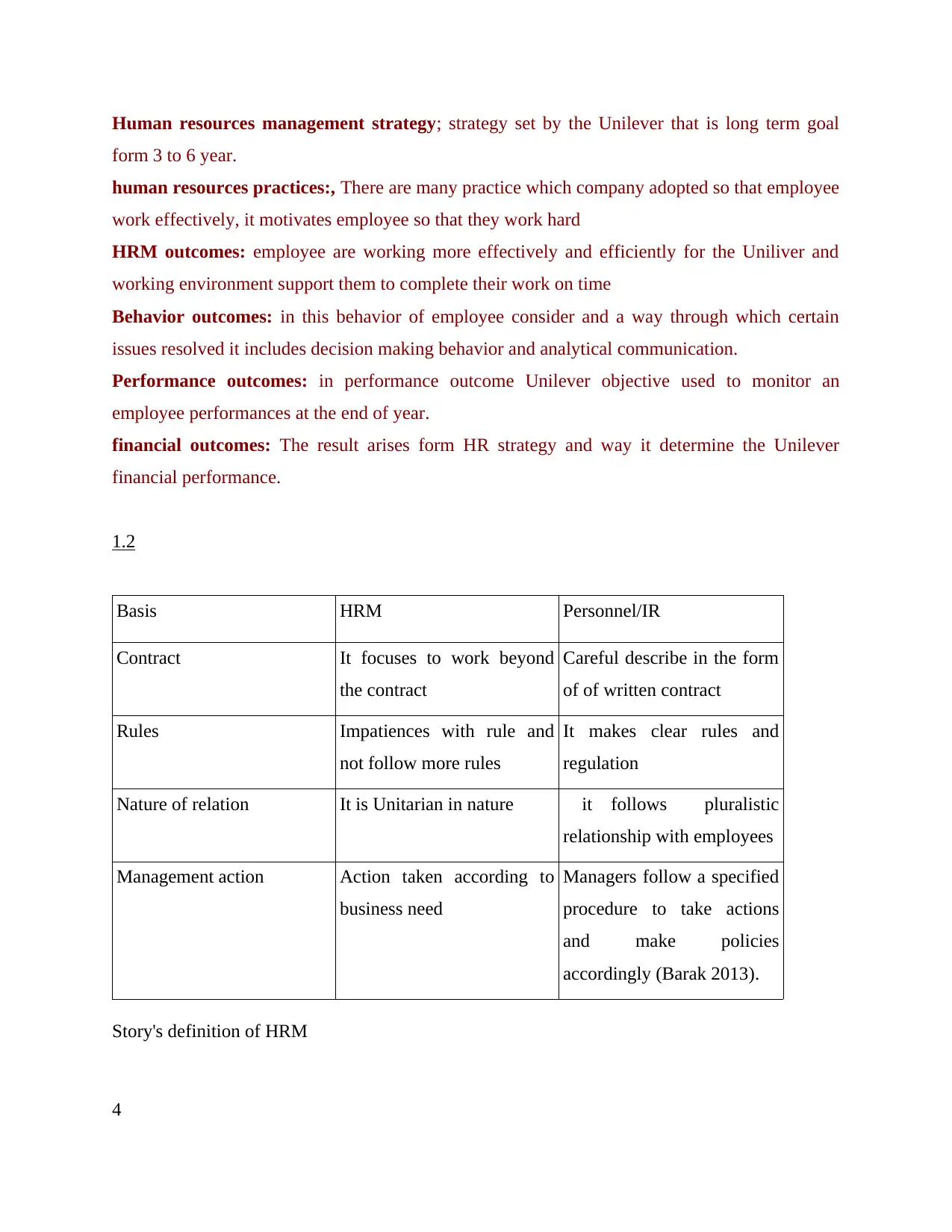
Human resources management strategy; strategy set by the Unilever that is long term goal
form 3 to 6 year.
human resources practices:, There are many practice which company adopted so that employee
work effectively, it motivates employee so that they work hard
HRM outcomes: employee are working more effectively and efficiently for the Uniliver and
working environment support them to complete their work on time
Behavior outcomes: in this behavior of employee consider and a way through which certain
issues resolved it includes decision making behavior and analytical communication.
Performance outcomes: in performance outcome Unilever objective used to monitor an
employee performances at the end of year.
financial outcomes: The result arises form HR strategy and way it determine the Unilever
financial performance.
1.2
Basis HRM Personnel/IR
Contract It focuses to work beyond
the contract
Careful describe in the form
of of written contract
Rules Impatiences with rule and
not follow more rules
It makes clear rules and
regulation
Nature of relation It is Unitarian in nature it follows pluralistic
relationship with employees
Management action Action taken according to
business need
Managers follow a specified
procedure to take actions
and make policies
accordingly (Barak 2013).
Story's definition of HRM
4
form 3 to 6 year.
human resources practices:, There are many practice which company adopted so that employee
work effectively, it motivates employee so that they work hard
HRM outcomes: employee are working more effectively and efficiently for the Uniliver and
working environment support them to complete their work on time
Behavior outcomes: in this behavior of employee consider and a way through which certain
issues resolved it includes decision making behavior and analytical communication.
Performance outcomes: in performance outcome Unilever objective used to monitor an
employee performances at the end of year.
financial outcomes: The result arises form HR strategy and way it determine the Unilever
financial performance.
1.2
Basis HRM Personnel/IR
Contract It focuses to work beyond
the contract
Careful describe in the form
of of written contract
Rules Impatiences with rule and
not follow more rules
It makes clear rules and
regulation
Nature of relation It is Unitarian in nature it follows pluralistic
relationship with employees
Management action Action taken according to
business need
Managers follow a specified
procedure to take actions
and make policies
accordingly (Barak 2013).
Story's definition of HRM
4
Paraphrase This Document
Need a fresh take? Get an instant paraphrase of this document with our AI Paraphraser
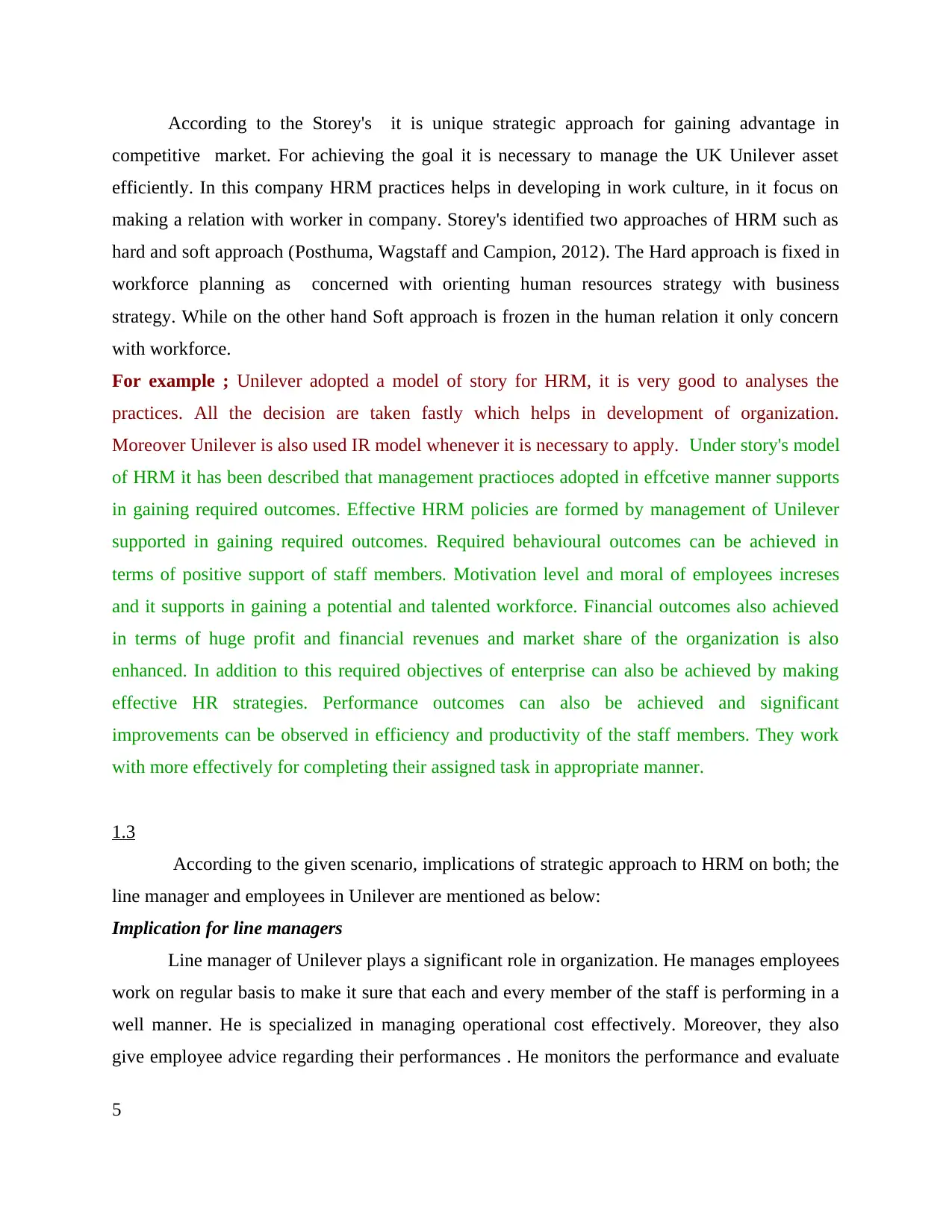
According to the Storey's it is unique strategic approach for gaining advantage in
competitive market. For achieving the goal it is necessary to manage the UK Unilever asset
efficiently. In this company HRM practices helps in developing in work culture, in it focus on
making a relation with worker in company. Storey's identified two approaches of HRM such as
hard and soft approach (Posthuma, Wagstaff and Campion, 2012). The Hard approach is fixed in
workforce planning as concerned with orienting human resources strategy with business
strategy. While on the other hand Soft approach is frozen in the human relation it only concern
with workforce.
For example ; Unilever adopted a model of story for HRM, it is very good to analyses the
practices. All the decision are taken fastly which helps in development of organization.
Moreover Unilever is also used IR model whenever it is necessary to apply. Under story's model
of HRM it has been described that management practioces adopted in effcetive manner supports
in gaining required outcomes. Effective HRM policies are formed by management of Unilever
supported in gaining required outcomes. Required behavioural outcomes can be achieved in
terms of positive support of staff members. Motivation level and moral of employees increses
and it supports in gaining a potential and talented workforce. Financial outcomes also achieved
in terms of huge profit and financial revenues and market share of the organization is also
enhanced. In addition to this required objectives of enterprise can also be achieved by making
effective HR strategies. Performance outcomes can also be achieved and significant
improvements can be observed in efficiency and productivity of the staff members. They work
with more effectively for completing their assigned task in appropriate manner.
1.3
According to the given scenario, implications of strategic approach to HRM on both; the
line manager and employees in Unilever are mentioned as below:
Implication for line managers
Line manager of Unilever plays a significant role in organization. He manages employees
work on regular basis to make it sure that each and every member of the staff is performing in a
well manner. He is specialized in managing operational cost effectively. Moreover, they also
give employee advice regarding their performances . He monitors the performance and evaluate
5
competitive market. For achieving the goal it is necessary to manage the UK Unilever asset
efficiently. In this company HRM practices helps in developing in work culture, in it focus on
making a relation with worker in company. Storey's identified two approaches of HRM such as
hard and soft approach (Posthuma, Wagstaff and Campion, 2012). The Hard approach is fixed in
workforce planning as concerned with orienting human resources strategy with business
strategy. While on the other hand Soft approach is frozen in the human relation it only concern
with workforce.
For example ; Unilever adopted a model of story for HRM, it is very good to analyses the
practices. All the decision are taken fastly which helps in development of organization.
Moreover Unilever is also used IR model whenever it is necessary to apply. Under story's model
of HRM it has been described that management practioces adopted in effcetive manner supports
in gaining required outcomes. Effective HRM policies are formed by management of Unilever
supported in gaining required outcomes. Required behavioural outcomes can be achieved in
terms of positive support of staff members. Motivation level and moral of employees increses
and it supports in gaining a potential and talented workforce. Financial outcomes also achieved
in terms of huge profit and financial revenues and market share of the organization is also
enhanced. In addition to this required objectives of enterprise can also be achieved by making
effective HR strategies. Performance outcomes can also be achieved and significant
improvements can be observed in efficiency and productivity of the staff members. They work
with more effectively for completing their assigned task in appropriate manner.
1.3
According to the given scenario, implications of strategic approach to HRM on both; the
line manager and employees in Unilever are mentioned as below:
Implication for line managers
Line manager of Unilever plays a significant role in organization. He manages employees
work on regular basis to make it sure that each and every member of the staff is performing in a
well manner. He is specialized in managing operational cost effectively. Moreover, they also
give employee advice regarding their performances . He monitors the performance and evaluate
5
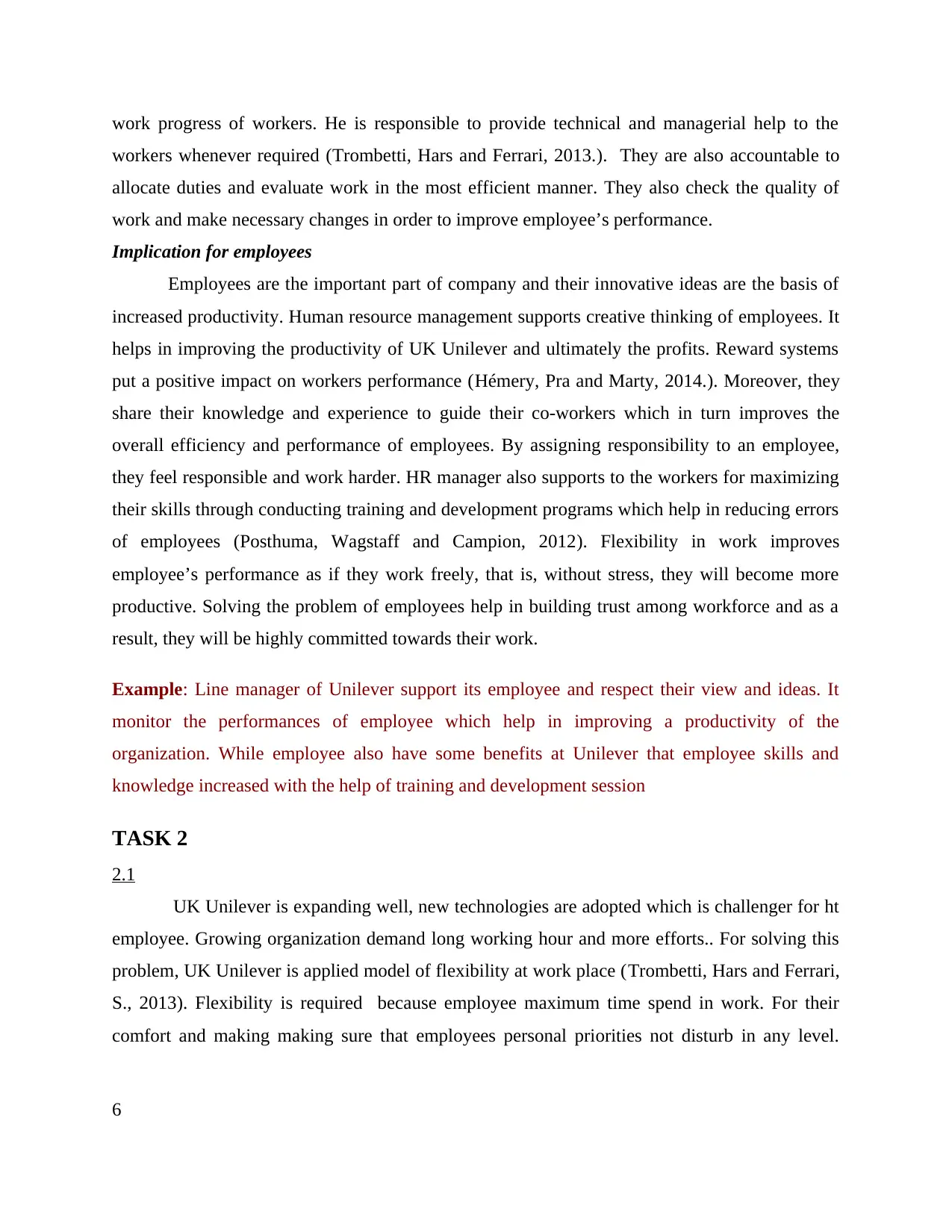
work progress of workers. He is responsible to provide technical and managerial help to the
workers whenever required (Trombetti, Hars and Ferrari, 2013.). They are also accountable to
allocate duties and evaluate work in the most efficient manner. They also check the quality of
work and make necessary changes in order to improve employee’s performance.
Implication for employees
Employees are the important part of company and their innovative ideas are the basis of
increased productivity. Human resource management supports creative thinking of employees. It
helps in improving the productivity of UK Unilever and ultimately the profits. Reward systems
put a positive impact on workers performance (Hémery, Pra and Marty, 2014.). Moreover, they
share their knowledge and experience to guide their co-workers which in turn improves the
overall efficiency and performance of employees. By assigning responsibility to an employee,
they feel responsible and work harder. HR manager also supports to the workers for maximizing
their skills through conducting training and development programs which help in reducing errors
of employees (Posthuma, Wagstaff and Campion, 2012). Flexibility in work improves
employee’s performance as if they work freely, that is, without stress, they will become more
productive. Solving the problem of employees help in building trust among workforce and as a
result, they will be highly committed towards their work.
Example: Line manager of Unilever support its employee and respect their view and ideas. It
monitor the performances of employee which help in improving a productivity of the
organization. While employee also have some benefits at Unilever that employee skills and
knowledge increased with the help of training and development session
TASK 2
2.1
UK Unilever is expanding well, new technologies are adopted which is challenger for ht
employee. Growing organization demand long working hour and more efforts.. For solving this
problem, UK Unilever is applied model of flexibility at work place (Trombetti, Hars and Ferrari,
S., 2013). Flexibility is required because employee maximum time spend in work. For their
comfort and making making sure that employees personal priorities not disturb in any level.
6
workers whenever required (Trombetti, Hars and Ferrari, 2013.). They are also accountable to
allocate duties and evaluate work in the most efficient manner. They also check the quality of
work and make necessary changes in order to improve employee’s performance.
Implication for employees
Employees are the important part of company and their innovative ideas are the basis of
increased productivity. Human resource management supports creative thinking of employees. It
helps in improving the productivity of UK Unilever and ultimately the profits. Reward systems
put a positive impact on workers performance (Hémery, Pra and Marty, 2014.). Moreover, they
share their knowledge and experience to guide their co-workers which in turn improves the
overall efficiency and performance of employees. By assigning responsibility to an employee,
they feel responsible and work harder. HR manager also supports to the workers for maximizing
their skills through conducting training and development programs which help in reducing errors
of employees (Posthuma, Wagstaff and Campion, 2012). Flexibility in work improves
employee’s performance as if they work freely, that is, without stress, they will become more
productive. Solving the problem of employees help in building trust among workforce and as a
result, they will be highly committed towards their work.
Example: Line manager of Unilever support its employee and respect their view and ideas. It
monitor the performances of employee which help in improving a productivity of the
organization. While employee also have some benefits at Unilever that employee skills and
knowledge increased with the help of training and development session
TASK 2
2.1
UK Unilever is expanding well, new technologies are adopted which is challenger for ht
employee. Growing organization demand long working hour and more efforts.. For solving this
problem, UK Unilever is applied model of flexibility at work place (Trombetti, Hars and Ferrari,
S., 2013). Flexibility is required because employee maximum time spend in work. For their
comfort and making making sure that employees personal priorities not disturb in any level.
6
⊘ This is a preview!⊘
Do you want full access?
Subscribe today to unlock all pages.

Trusted by 1+ million students worldwide
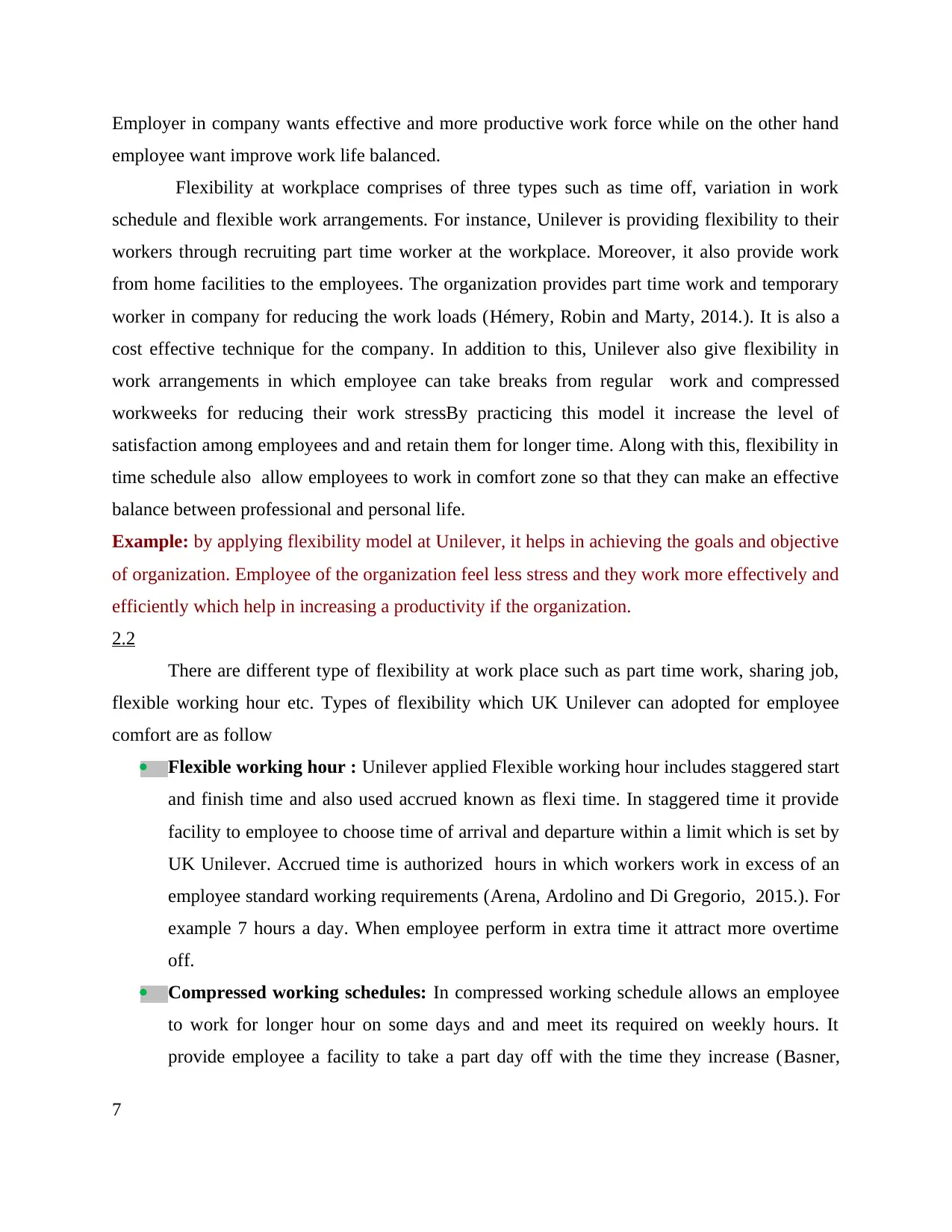
Employer in company wants effective and more productive work force while on the other hand
employee want improve work life balanced.
Flexibility at workplace comprises of three types such as time off, variation in work
schedule and flexible work arrangements. For instance, Unilever is providing flexibility to their
workers through recruiting part time worker at the workplace. Moreover, it also provide work
from home facilities to the employees. The organization provides part time work and temporary
worker in company for reducing the work loads (Hémery, Robin and Marty, 2014.). It is also a
cost effective technique for the company. In addition to this, Unilever also give flexibility in
work arrangements in which employee can take breaks from regular work and compressed
workweeks for reducing their work stressBy practicing this model it increase the level of
satisfaction among employees and and retain them for longer time. Along with this, flexibility in
time schedule also allow employees to work in comfort zone so that they can make an effective
balance between professional and personal life.
Example: by applying flexibility model at Unilever, it helps in achieving the goals and objective
of organization. Employee of the organization feel less stress and they work more effectively and
efficiently which help in increasing a productivity if the organization.
2.2
There are different type of flexibility at work place such as part time work, sharing job,
flexible working hour etc. Types of flexibility which UK Unilever can adopted for employee
comfort are as follow
Flexible working hour : Unilever applied Flexible working hour includes staggered start
and finish time and also used accrued known as flexi time. In staggered time it provide
facility to employee to choose time of arrival and departure within a limit which is set by
UK Unilever. Accrued time is authorized hours in which workers work in excess of an
employee standard working requirements (Arena, Ardolino and Di Gregorio, 2015.). For
example 7 hours a day. When employee perform in extra time it attract more overtime
off.
Compressed working schedules: In compressed working schedule allows an employee
to work for longer hour on some days and and meet its required on weekly hours. It
provide employee a facility to take a part day off with the time they increase (Basner,
7
employee want improve work life balanced.
Flexibility at workplace comprises of three types such as time off, variation in work
schedule and flexible work arrangements. For instance, Unilever is providing flexibility to their
workers through recruiting part time worker at the workplace. Moreover, it also provide work
from home facilities to the employees. The organization provides part time work and temporary
worker in company for reducing the work loads (Hémery, Robin and Marty, 2014.). It is also a
cost effective technique for the company. In addition to this, Unilever also give flexibility in
work arrangements in which employee can take breaks from regular work and compressed
workweeks for reducing their work stressBy practicing this model it increase the level of
satisfaction among employees and and retain them for longer time. Along with this, flexibility in
time schedule also allow employees to work in comfort zone so that they can make an effective
balance between professional and personal life.
Example: by applying flexibility model at Unilever, it helps in achieving the goals and objective
of organization. Employee of the organization feel less stress and they work more effectively and
efficiently which help in increasing a productivity if the organization.
2.2
There are different type of flexibility at work place such as part time work, sharing job,
flexible working hour etc. Types of flexibility which UK Unilever can adopted for employee
comfort are as follow
Flexible working hour : Unilever applied Flexible working hour includes staggered start
and finish time and also used accrued known as flexi time. In staggered time it provide
facility to employee to choose time of arrival and departure within a limit which is set by
UK Unilever. Accrued time is authorized hours in which workers work in excess of an
employee standard working requirements (Arena, Ardolino and Di Gregorio, 2015.). For
example 7 hours a day. When employee perform in extra time it attract more overtime
off.
Compressed working schedules: In compressed working schedule allows an employee
to work for longer hour on some days and and meet its required on weekly hours. It
provide employee a facility to take a part day off with the time they increase (Basner,
7
Paraphrase This Document
Need a fresh take? Get an instant paraphrase of this document with our AI Paraphraser
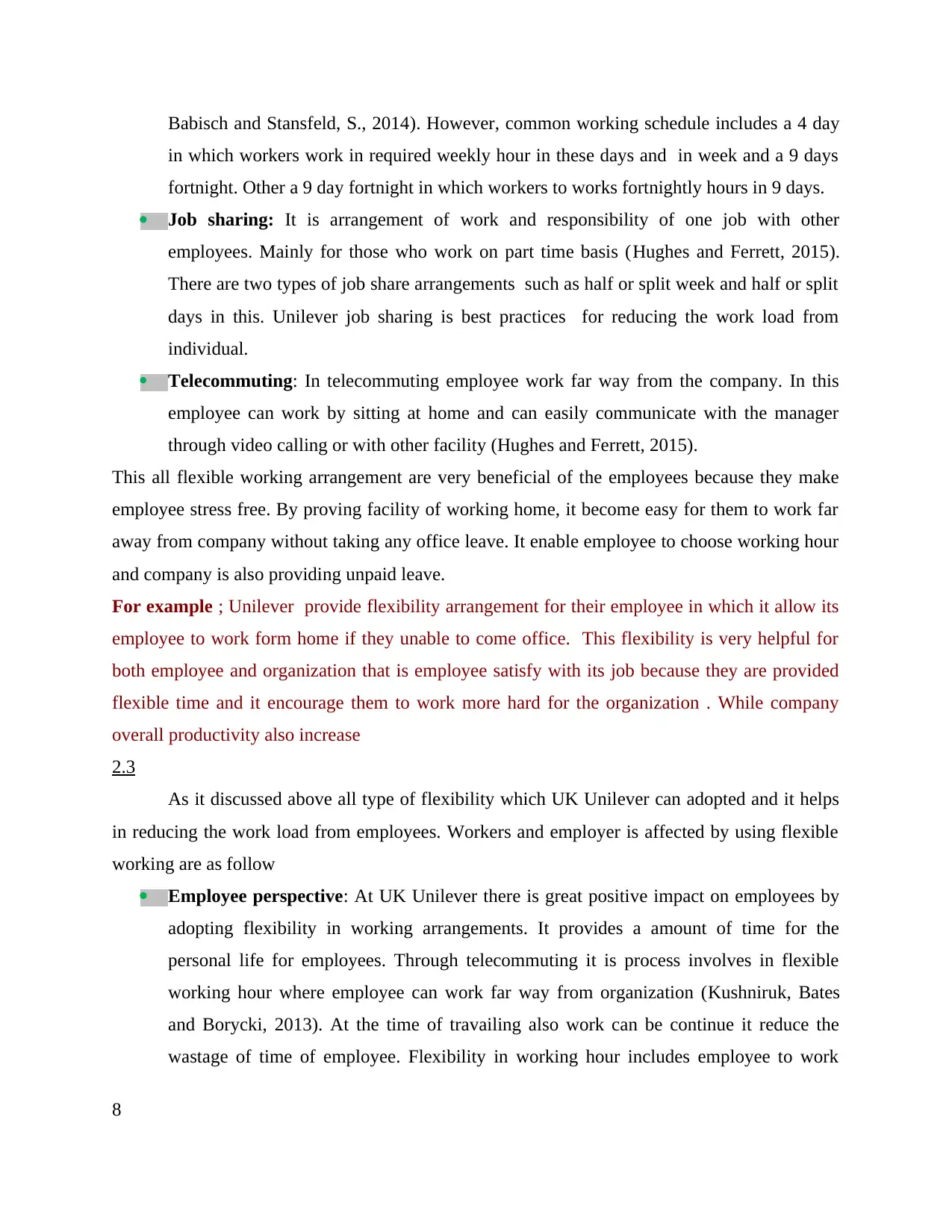
Babisch and Stansfeld, S., 2014). However, common working schedule includes a 4 day
in which workers work in required weekly hour in these days and in week and a 9 days
fortnight. Other a 9 day fortnight in which workers to works fortnightly hours in 9 days.
Job sharing: It is arrangement of work and responsibility of one job with other
employees. Mainly for those who work on part time basis (Hughes and Ferrett, 2015).
There are two types of job share arrangements such as half or split week and half or split
days in this. Unilever job sharing is best practices for reducing the work load from
individual.
Telecommuting: In telecommuting employee work far way from the company. In this
employee can work by sitting at home and can easily communicate with the manager
through video calling or with other facility (Hughes and Ferrett, 2015).
This all flexible working arrangement are very beneficial of the employees because they make
employee stress free. By proving facility of working home, it become easy for them to work far
away from company without taking any office leave. It enable employee to choose working hour
and company is also providing unpaid leave.
For example ; Unilever provide flexibility arrangement for their employee in which it allow its
employee to work form home if they unable to come office. This flexibility is very helpful for
both employee and organization that is employee satisfy with its job because they are provided
flexible time and it encourage them to work more hard for the organization . While company
overall productivity also increase
2.3
As it discussed above all type of flexibility which UK Unilever can adopted and it helps
in reducing the work load from employees. Workers and employer is affected by using flexible
working are as follow
Employee perspective: At UK Unilever there is great positive impact on employees by
adopting flexibility in working arrangements. It provides a amount of time for the
personal life for employees. Through telecommuting it is process involves in flexible
working hour where employee can work far way from organization (Kushniruk, Bates
and Borycki, 2013). At the time of travailing also work can be continue it reduce the
wastage of time of employee. Flexibility in working hour includes employee to work
8
in which workers work in required weekly hour in these days and in week and a 9 days
fortnight. Other a 9 day fortnight in which workers to works fortnightly hours in 9 days.
Job sharing: It is arrangement of work and responsibility of one job with other
employees. Mainly for those who work on part time basis (Hughes and Ferrett, 2015).
There are two types of job share arrangements such as half or split week and half or split
days in this. Unilever job sharing is best practices for reducing the work load from
individual.
Telecommuting: In telecommuting employee work far way from the company. In this
employee can work by sitting at home and can easily communicate with the manager
through video calling or with other facility (Hughes and Ferrett, 2015).
This all flexible working arrangement are very beneficial of the employees because they make
employee stress free. By proving facility of working home, it become easy for them to work far
away from company without taking any office leave. It enable employee to choose working hour
and company is also providing unpaid leave.
For example ; Unilever provide flexibility arrangement for their employee in which it allow its
employee to work form home if they unable to come office. This flexibility is very helpful for
both employee and organization that is employee satisfy with its job because they are provided
flexible time and it encourage them to work more hard for the organization . While company
overall productivity also increase
2.3
As it discussed above all type of flexibility which UK Unilever can adopted and it helps
in reducing the work load from employees. Workers and employer is affected by using flexible
working are as follow
Employee perspective: At UK Unilever there is great positive impact on employees by
adopting flexibility in working arrangements. It provides a amount of time for the
personal life for employees. Through telecommuting it is process involves in flexible
working hour where employee can work far way from organization (Kushniruk, Bates
and Borycki, 2013). At the time of travailing also work can be continue it reduce the
wastage of time of employee. Flexibility in working hour includes employee to work
8
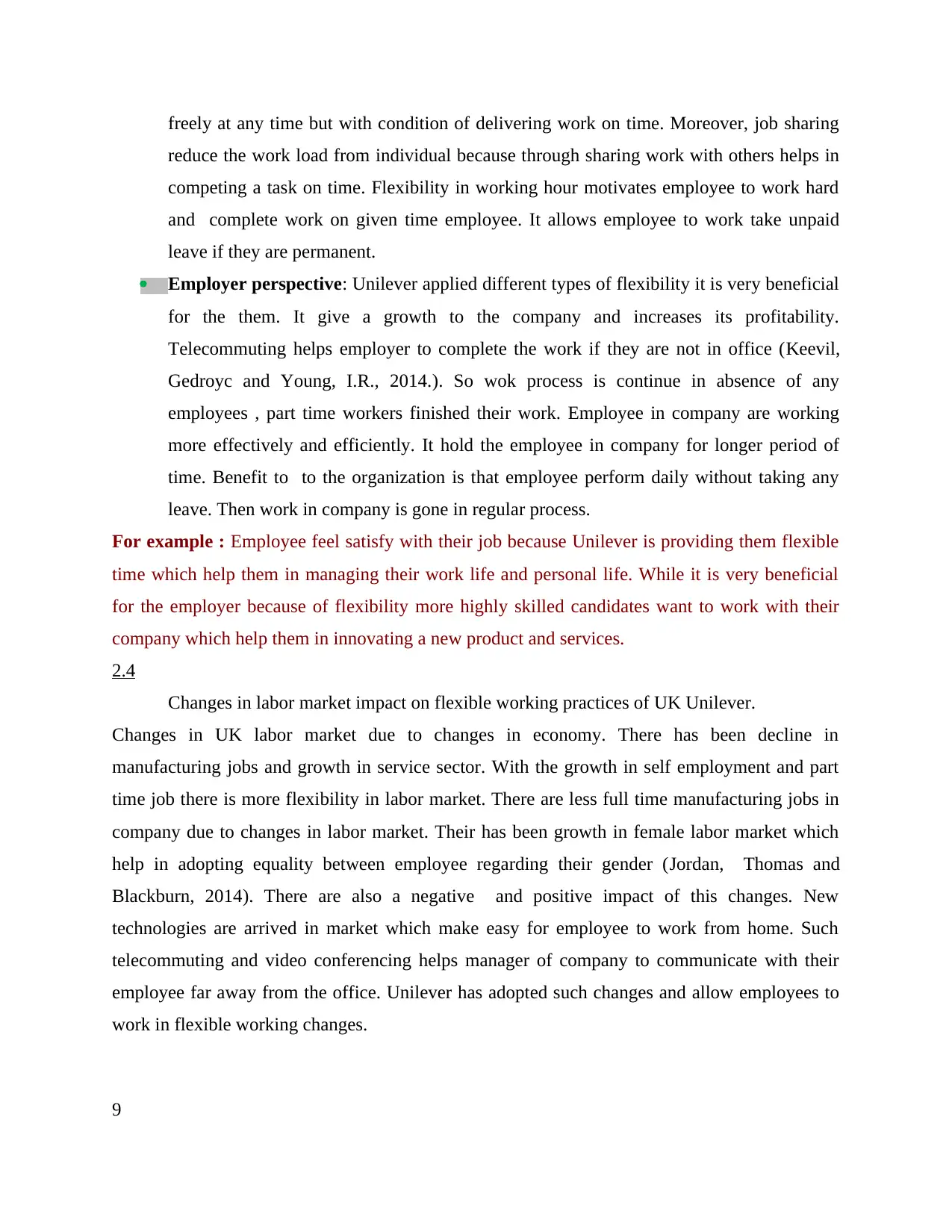
freely at any time but with condition of delivering work on time. Moreover, job sharing
reduce the work load from individual because through sharing work with others helps in
competing a task on time. Flexibility in working hour motivates employee to work hard
and complete work on given time employee. It allows employee to work take unpaid
leave if they are permanent.
Employer perspective: Unilever applied different types of flexibility it is very beneficial
for the them. It give a growth to the company and increases its profitability.
Telecommuting helps employer to complete the work if they are not in office (Keevil,
Gedroyc and Young, I.R., 2014.). So wok process is continue in absence of any
employees , part time workers finished their work. Employee in company are working
more effectively and efficiently. It hold the employee in company for longer period of
time. Benefit to to the organization is that employee perform daily without taking any
leave. Then work in company is gone in regular process.
For example : Employee feel satisfy with their job because Unilever is providing them flexible
time which help them in managing their work life and personal life. While it is very beneficial
for the employer because of flexibility more highly skilled candidates want to work with their
company which help them in innovating a new product and services.
2.4
Changes in labor market impact on flexible working practices of UK Unilever.
Changes in UK labor market due to changes in economy. There has been decline in
manufacturing jobs and growth in service sector. With the growth in self employment and part
time job there is more flexibility in labor market. There are less full time manufacturing jobs in
company due to changes in labor market. Their has been growth in female labor market which
help in adopting equality between employee regarding their gender (Jordan, Thomas and
Blackburn, 2014). There are also a negative and positive impact of this changes. New
technologies are arrived in market which make easy for employee to work from home. Such
telecommuting and video conferencing helps manager of company to communicate with their
employee far away from the office. Unilever has adopted such changes and allow employees to
work in flexible working changes.
9
reduce the work load from individual because through sharing work with others helps in
competing a task on time. Flexibility in working hour motivates employee to work hard
and complete work on given time employee. It allows employee to work take unpaid
leave if they are permanent.
Employer perspective: Unilever applied different types of flexibility it is very beneficial
for the them. It give a growth to the company and increases its profitability.
Telecommuting helps employer to complete the work if they are not in office (Keevil,
Gedroyc and Young, I.R., 2014.). So wok process is continue in absence of any
employees , part time workers finished their work. Employee in company are working
more effectively and efficiently. It hold the employee in company for longer period of
time. Benefit to to the organization is that employee perform daily without taking any
leave. Then work in company is gone in regular process.
For example : Employee feel satisfy with their job because Unilever is providing them flexible
time which help them in managing their work life and personal life. While it is very beneficial
for the employer because of flexibility more highly skilled candidates want to work with their
company which help them in innovating a new product and services.
2.4
Changes in labor market impact on flexible working practices of UK Unilever.
Changes in UK labor market due to changes in economy. There has been decline in
manufacturing jobs and growth in service sector. With the growth in self employment and part
time job there is more flexibility in labor market. There are less full time manufacturing jobs in
company due to changes in labor market. Their has been growth in female labor market which
help in adopting equality between employee regarding their gender (Jordan, Thomas and
Blackburn, 2014). There are also a negative and positive impact of this changes. New
technologies are arrived in market which make easy for employee to work from home. Such
telecommuting and video conferencing helps manager of company to communicate with their
employee far away from the office. Unilever has adopted such changes and allow employees to
work in flexible working changes.
9
⊘ This is a preview!⊘
Do you want full access?
Subscribe today to unlock all pages.

Trusted by 1+ million students worldwide
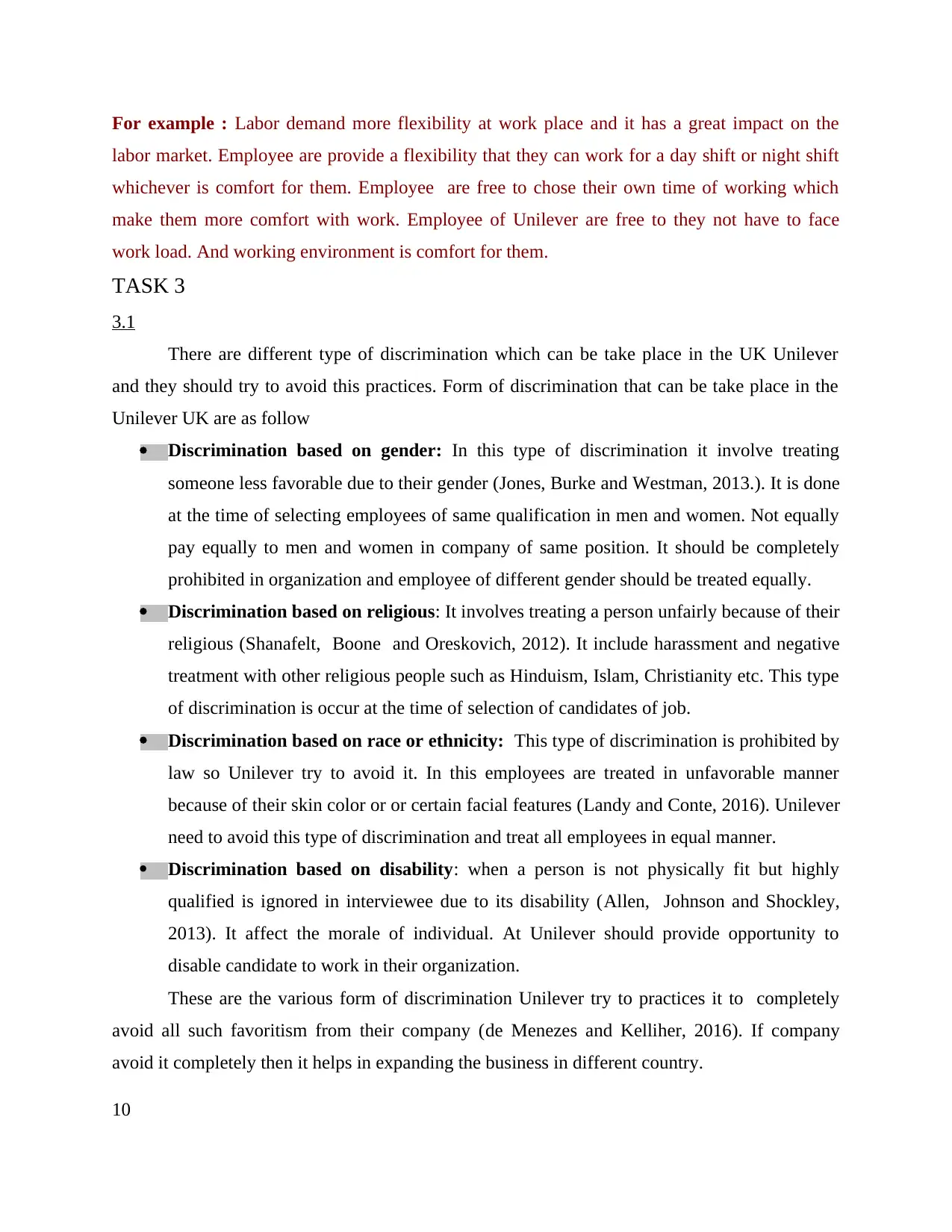
For example : Labor demand more flexibility at work place and it has a great impact on the
labor market. Employee are provide a flexibility that they can work for a day shift or night shift
whichever is comfort for them. Employee are free to chose their own time of working which
make them more comfort with work. Employee of Unilever are free to they not have to face
work load. And working environment is comfort for them.
TASK 3
3.1
There are different type of discrimination which can be take place in the UK Unilever
and they should try to avoid this practices. Form of discrimination that can be take place in the
Unilever UK are as follow
Discrimination based on gender: In this type of discrimination it involve treating
someone less favorable due to their gender (Jones, Burke and Westman, 2013.). It is done
at the time of selecting employees of same qualification in men and women. Not equally
pay equally to men and women in company of same position. It should be completely
prohibited in organization and employee of different gender should be treated equally.
Discrimination based on religious: It involves treating a person unfairly because of their
religious (Shanafelt, Boone and Oreskovich, 2012). It include harassment and negative
treatment with other religious people such as Hinduism, Islam, Christianity etc. This type
of discrimination is occur at the time of selection of candidates of job.
Discrimination based on race or ethnicity: This type of discrimination is prohibited by
law so Unilever try to avoid it. In this employees are treated in unfavorable manner
because of their skin color or or certain facial features (Landy and Conte, 2016). Unilever
need to avoid this type of discrimination and treat all employees in equal manner.
Discrimination based on disability: when a person is not physically fit but highly
qualified is ignored in interviewee due to its disability (Allen, Johnson and Shockley,
2013). It affect the morale of individual. At Unilever should provide opportunity to
disable candidate to work in their organization.
These are the various form of discrimination Unilever try to practices it to completely
avoid all such favoritism from their company (de Menezes and Kelliher, 2016). If company
avoid it completely then it helps in expanding the business in different country.
10
labor market. Employee are provide a flexibility that they can work for a day shift or night shift
whichever is comfort for them. Employee are free to chose their own time of working which
make them more comfort with work. Employee of Unilever are free to they not have to face
work load. And working environment is comfort for them.
TASK 3
3.1
There are different type of discrimination which can be take place in the UK Unilever
and they should try to avoid this practices. Form of discrimination that can be take place in the
Unilever UK are as follow
Discrimination based on gender: In this type of discrimination it involve treating
someone less favorable due to their gender (Jones, Burke and Westman, 2013.). It is done
at the time of selecting employees of same qualification in men and women. Not equally
pay equally to men and women in company of same position. It should be completely
prohibited in organization and employee of different gender should be treated equally.
Discrimination based on religious: It involves treating a person unfairly because of their
religious (Shanafelt, Boone and Oreskovich, 2012). It include harassment and negative
treatment with other religious people such as Hinduism, Islam, Christianity etc. This type
of discrimination is occur at the time of selection of candidates of job.
Discrimination based on race or ethnicity: This type of discrimination is prohibited by
law so Unilever try to avoid it. In this employees are treated in unfavorable manner
because of their skin color or or certain facial features (Landy and Conte, 2016). Unilever
need to avoid this type of discrimination and treat all employees in equal manner.
Discrimination based on disability: when a person is not physically fit but highly
qualified is ignored in interviewee due to its disability (Allen, Johnson and Shockley,
2013). It affect the morale of individual. At Unilever should provide opportunity to
disable candidate to work in their organization.
These are the various form of discrimination Unilever try to practices it to completely
avoid all such favoritism from their company (de Menezes and Kelliher, 2016). If company
avoid it completely then it helps in expanding the business in different country.
10
Paraphrase This Document
Need a fresh take? Get an instant paraphrase of this document with our AI Paraphraser
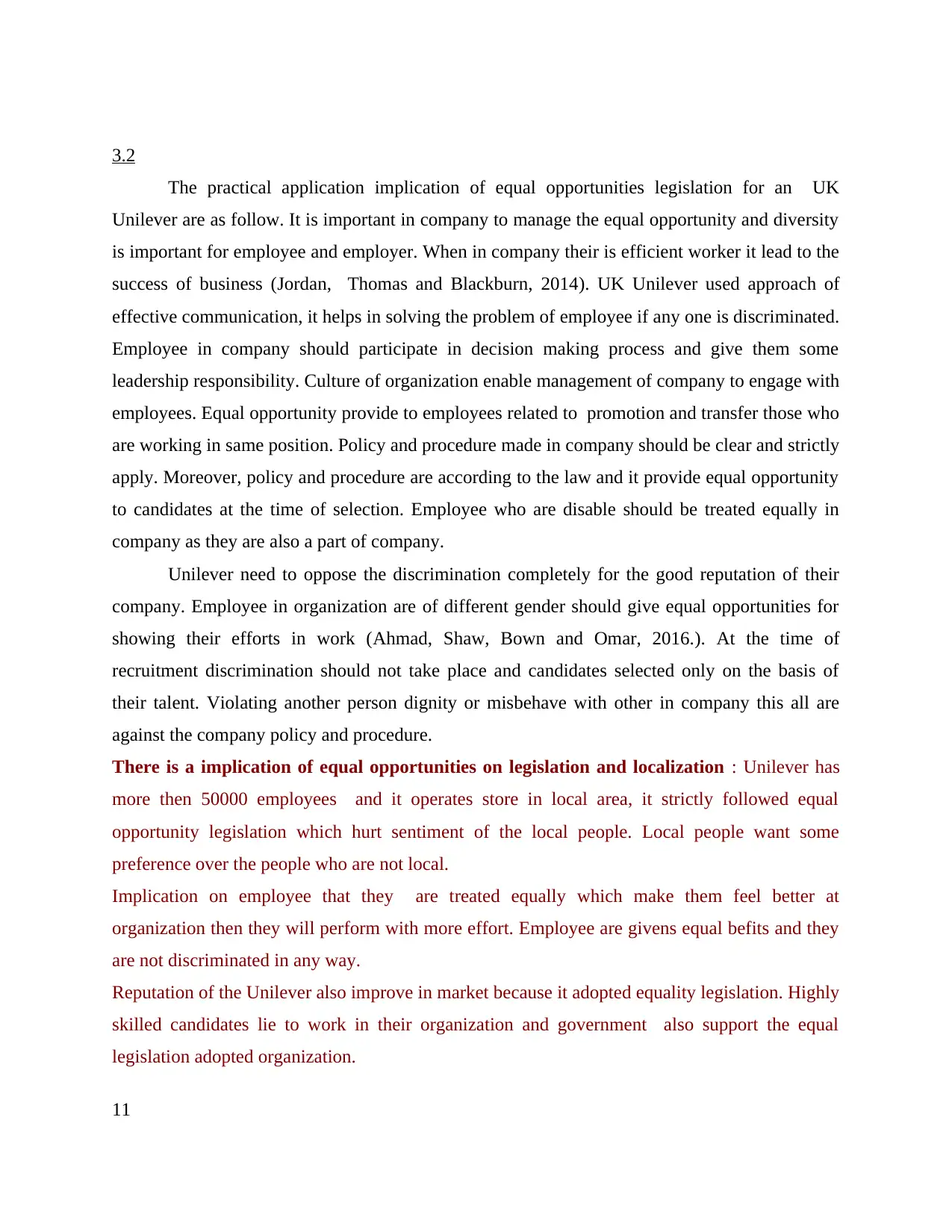
3.2
The practical application implication of equal opportunities legislation for an UK
Unilever are as follow. It is important in company to manage the equal opportunity and diversity
is important for employee and employer. When in company their is efficient worker it lead to the
success of business (Jordan, Thomas and Blackburn, 2014). UK Unilever used approach of
effective communication, it helps in solving the problem of employee if any one is discriminated.
Employee in company should participate in decision making process and give them some
leadership responsibility. Culture of organization enable management of company to engage with
employees. Equal opportunity provide to employees related to promotion and transfer those who
are working in same position. Policy and procedure made in company should be clear and strictly
apply. Moreover, policy and procedure are according to the law and it provide equal opportunity
to candidates at the time of selection. Employee who are disable should be treated equally in
company as they are also a part of company.
Unilever need to oppose the discrimination completely for the good reputation of their
company. Employee in organization are of different gender should give equal opportunities for
showing their efforts in work (Ahmad, Shaw, Bown and Omar, 2016.). At the time of
recruitment discrimination should not take place and candidates selected only on the basis of
their talent. Violating another person dignity or misbehave with other in company this all are
against the company policy and procedure.
There is a implication of equal opportunities on legislation and localization : Unilever has
more then 50000 employees and it operates store in local area, it strictly followed equal
opportunity legislation which hurt sentiment of the local people. Local people want some
preference over the people who are not local.
Implication on employee that they are treated equally which make them feel better at
organization then they will perform with more effort. Employee are givens equal befits and they
are not discriminated in any way.
Reputation of the Unilever also improve in market because it adopted equality legislation. Highly
skilled candidates lie to work in their organization and government also support the equal
legislation adopted organization.
11
The practical application implication of equal opportunities legislation for an UK
Unilever are as follow. It is important in company to manage the equal opportunity and diversity
is important for employee and employer. When in company their is efficient worker it lead to the
success of business (Jordan, Thomas and Blackburn, 2014). UK Unilever used approach of
effective communication, it helps in solving the problem of employee if any one is discriminated.
Employee in company should participate in decision making process and give them some
leadership responsibility. Culture of organization enable management of company to engage with
employees. Equal opportunity provide to employees related to promotion and transfer those who
are working in same position. Policy and procedure made in company should be clear and strictly
apply. Moreover, policy and procedure are according to the law and it provide equal opportunity
to candidates at the time of selection. Employee who are disable should be treated equally in
company as they are also a part of company.
Unilever need to oppose the discrimination completely for the good reputation of their
company. Employee in organization are of different gender should give equal opportunities for
showing their efforts in work (Ahmad, Shaw, Bown and Omar, 2016.). At the time of
recruitment discrimination should not take place and candidates selected only on the basis of
their talent. Violating another person dignity or misbehave with other in company this all are
against the company policy and procedure.
There is a implication of equal opportunities on legislation and localization : Unilever has
more then 50000 employees and it operates store in local area, it strictly followed equal
opportunity legislation which hurt sentiment of the local people. Local people want some
preference over the people who are not local.
Implication on employee that they are treated equally which make them feel better at
organization then they will perform with more effort. Employee are givens equal befits and they
are not discriminated in any way.
Reputation of the Unilever also improve in market because it adopted equality legislation. Highly
skilled candidates lie to work in their organization and government also support the equal
legislation adopted organization.
11
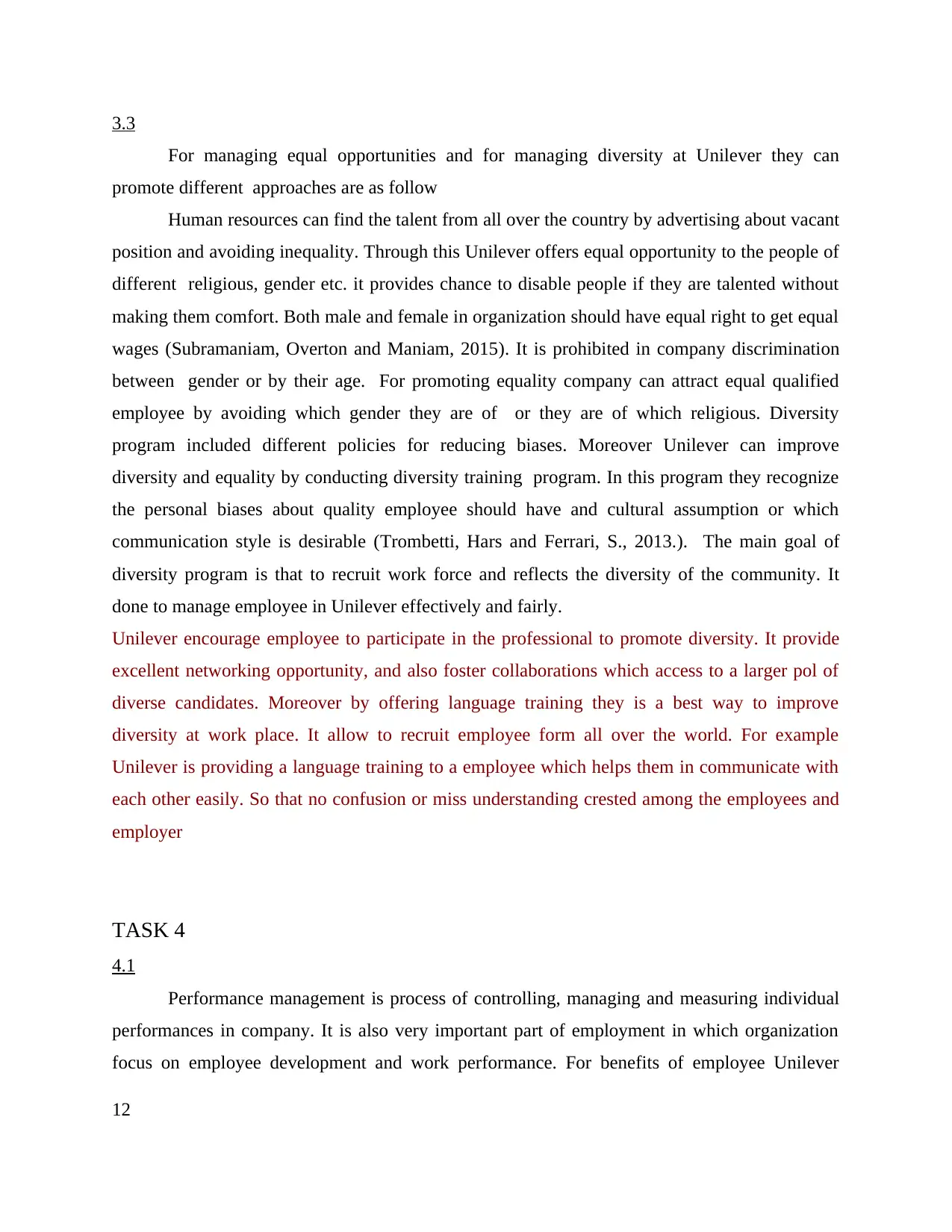
3.3
For managing equal opportunities and for managing diversity at Unilever they can
promote different approaches are as follow
Human resources can find the talent from all over the country by advertising about vacant
position and avoiding inequality. Through this Unilever offers equal opportunity to the people of
different religious, gender etc. it provides chance to disable people if they are talented without
making them comfort. Both male and female in organization should have equal right to get equal
wages (Subramaniam, Overton and Maniam, 2015). It is prohibited in company discrimination
between gender or by their age. For promoting equality company can attract equal qualified
employee by avoiding which gender they are of or they are of which religious. Diversity
program included different policies for reducing biases. Moreover Unilever can improve
diversity and equality by conducting diversity training program. In this program they recognize
the personal biases about quality employee should have and cultural assumption or which
communication style is desirable (Trombetti, Hars and Ferrari, S., 2013.). The main goal of
diversity program is that to recruit work force and reflects the diversity of the community. It
done to manage employee in Unilever effectively and fairly.
Unilever encourage employee to participate in the professional to promote diversity. It provide
excellent networking opportunity, and also foster collaborations which access to a larger pol of
diverse candidates. Moreover by offering language training they is a best way to improve
diversity at work place. It allow to recruit employee form all over the world. For example
Unilever is providing a language training to a employee which helps them in communicate with
each other easily. So that no confusion or miss understanding crested among the employees and
employer
TASK 4
4.1
Performance management is process of controlling, managing and measuring individual
performances in company. It is also very important part of employment in which organization
focus on employee development and work performance. For benefits of employee Unilever
12
For managing equal opportunities and for managing diversity at Unilever they can
promote different approaches are as follow
Human resources can find the talent from all over the country by advertising about vacant
position and avoiding inequality. Through this Unilever offers equal opportunity to the people of
different religious, gender etc. it provides chance to disable people if they are talented without
making them comfort. Both male and female in organization should have equal right to get equal
wages (Subramaniam, Overton and Maniam, 2015). It is prohibited in company discrimination
between gender or by their age. For promoting equality company can attract equal qualified
employee by avoiding which gender they are of or they are of which religious. Diversity
program included different policies for reducing biases. Moreover Unilever can improve
diversity and equality by conducting diversity training program. In this program they recognize
the personal biases about quality employee should have and cultural assumption or which
communication style is desirable (Trombetti, Hars and Ferrari, S., 2013.). The main goal of
diversity program is that to recruit work force and reflects the diversity of the community. It
done to manage employee in Unilever effectively and fairly.
Unilever encourage employee to participate in the professional to promote diversity. It provide
excellent networking opportunity, and also foster collaborations which access to a larger pol of
diverse candidates. Moreover by offering language training they is a best way to improve
diversity at work place. It allow to recruit employee form all over the world. For example
Unilever is providing a language training to a employee which helps them in communicate with
each other easily. So that no confusion or miss understanding crested among the employees and
employer
TASK 4
4.1
Performance management is process of controlling, managing and measuring individual
performances in company. It is also very important part of employment in which organization
focus on employee development and work performance. For benefits of employee Unilever
12
⊘ This is a preview!⊘
Do you want full access?
Subscribe today to unlock all pages.

Trusted by 1+ million students worldwide
1 out of 22
Related Documents
Your All-in-One AI-Powered Toolkit for Academic Success.
+13062052269
info@desklib.com
Available 24*7 on WhatsApp / Email
![[object Object]](/_next/static/media/star-bottom.7253800d.svg)
Unlock your academic potential
Copyright © 2020–2025 A2Z Services. All Rights Reserved. Developed and managed by ZUCOL.





